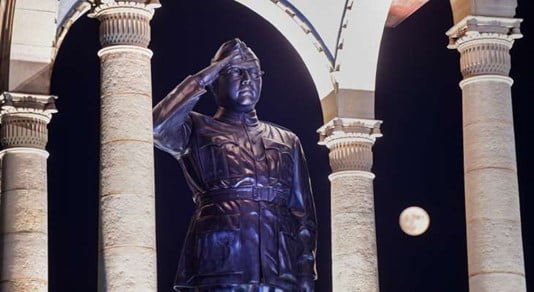History and Art and Culture
In News: A statue of Subhas Chandra Bose was unveiled by Prime Minister at India Gate, inaugurated along with the Kartavya Path that was earlier known as Rajpath.

Subhas Chandra Bose’s early life
- Born to an upper-class Bengali family in 1897 in Cuttack, Subhas Chandra Bose was the ninth child of Janakinath and Prabhavati Bose.
- In 1909, S C Bose moved to Ravenshaw Collegiate School, where he completed his secondary education.
- While he continued his European education throughout his life, he became less drawn to Anglicized ways than his family.
- Influenced by the teachings of Ramakrishna and his disciple Swami Vivekananda, as well as the themes of Bengali novelist Bankim Chandra Chatterjee in his novel Ananda Math, Subhas found what he was looking for: “his Motherland’s freedom and revival”.
- After school, he entered the Presidency College in Calcutta in 1913, where he studied philosophy.
- His earliest battle with British authority occurred while he was a student, against Professor of History E F Oaten, who had once in class spoken about England’s civilizing mission in India.
- Afterwards, Bose went to Cambridge University to prepare for the Indian Civil Services (ICS) exam in 1920.
- But later, determined to join the struggle for India’s freedom, he abandoned the project and resigned from the ICS to join the Mahatma Gandhi-led national movement.
Bose’s Disagreements with Gandhi
- After reaching Bombay, now Mumbai, in 1921, he obtained an audience with Gandhi to get a better understanding of his plan of action.
- While Gandhiji was willing to wait a long time for Independence, Bose wanted immediate action, if not immediate results.
- Gandhiji was anti-materialistic and hostile to modern technology, Bose saw technology and mass production as essential to survival and dignity.
- Gandhiji wanted a decentralized society and disliked the modern state; Bose wanted a strong central government and saw the modern state as the only solution to India’s problems.
- And finally, Bose did not share Gandhi’s dedication to non-violence.
- Despite tensions between the two, Bose was well aware of the significance of a leader like Gandhi. Bose was the first to call him the “father of the nation” during an address from the Azad Hind Radio from Singapore in July 1944.
The rift within the Congress
- Bose devoted his life to the nationalist movement, gaining considerable political influence and becoming one of the most powerful leaders in the Congress party.
- In 1938, he was elected Congress president in the Haripura session, where he tried to push for swaraj as a “National Demand” and opposed the idea of an Indian federation under British rule.
- He stood for re-election in 1939 and defeated Dr Pattabhi Sitaramayya, the Gandhiji-backed candidate.
- 12 of the 15 members of the Working Committee resigned from their roles
- Bose tried to set up another working committee, but after being unable to do so, was forced to resign and was replaced by Prasad.
- Within a week, he created the “Forward Bloc” within the Congress Party, in order to bring the radical-left elements of the party together.
A dramatic escape
- Bose was arrested in 1940 before he could launch a campaign to remove the monument dedicated to the victims of the Black Hole of Calcutta, an incident when a number of European soldiers died while imprisoned in 1756.
- After going on a hunger strike, he was released from jail in December.
- He soon began his escape from India, travelling by road, rail, air and foot in various disguises to avoid British surveillance.
- He entered Soviet-controlled Kabul via the northwest of India and finally reached Nazi Germany, where he remained for two years.
- He was provided assistance to defeat the British, and Bose was allowed to start the Azad Hind Radio and was provided with a few thousand Indian prisoners of war captured by Germany.
- Bose soon turned his focus to South East Asia, specifically Singapore, a British stronghold that had been taken over by Japan
The INA and World War II
- The Indian National Army was formed in 1942, consisting of thousands of Indian prisoners of war captured by the Japanese, and supported by Japanese troops.
- After his arrival in Singapore, Bose, issued from there his famous call, ‘Delhi Chalo’, and announced the formation of the Azad Hind Government and the Indian National Army on 21st October 1943.
- The headquarters of the provisional government was moved to Rangoon in January 1944, and after fighting at the Arakan Front, the INA crossed the Indo-Burma border and marched towards Imphal and Kohima in March.
- The Chalo Delhi campaign ended at Imphal however, as the British and British Indian armies, were able to defeat the Japanese forces and the INA and push them out of Kohima as well.
- After the Japanese surrendered on August 16, Bose left South East Asia on a Japanese plane and headed toward China. The plane, however, crashed, leaving Bose badly burned and dead.
Source: Indian Express
Previous Year Question
Q.1) He wrote biographies of Mazzini, Garibaldi, Shivaji and Shrikrishna; stayed in America for some time; and was also elected to the Central Assembly. He was (2018)
- Aurobindo Ghosh
- Bipin Chandra Pal
- Lala Lajpat Rai
- Motilal Nehru














